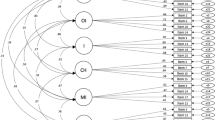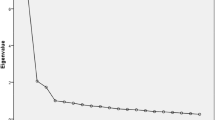Abstract
Objectives
Three studies were conducted to develop an age-appropriate scale to assess children’s self-compassionate reactions by using a vignette technique.
Methods
In Study 1, a scale employing vignette technique was developed first based on self-compassion theory and interview with children. Next, based on further item analysis with 161 children, two items were eliminated and three were modified to form the Self-Compassionate Reactions Scale for Children (SCRS-C), including 4 vignettes and 24 items. In Study 2, serial CFAs (N = 637) were conducted to investigate the structure, factorial invariance, and equivalence across gender of the SCRS-C. The reliability, convergent and discriminate validity, and concurrent validity were also examined. Study 3 explored the test-retest reliability of the scale over 6 weeks (N = 77).
Results
A two second-order factor model (compassionate and uncompassionate reaction) with six first-order factors (self-kindness, common humanity, mindfulness, self-judgment, isolation, and over-identification) was found to best fit the data. In addition, the factorial invariance of the second-order factor structure across gender was verified, and the internal consistency reliability was satisfactory. The scale showed satisfactory convergent, discriminate and concurrent validity and test-retest reliability.
Conclusions
The SCRS-C shows promise as a reliable and valid scale of self-compassion suited for children aged 9–12 for both boys and girls.

Similar content being viewed by others
References
Bluth, K., & Blanton, P. W. (2014). Mindfulness and self-compassion: exploring pathways to adolescent emotional well-being. Journal of Child and Family Studies, 22, 1298–1309.
Bluth, K., & Blanton, P. W. (2015). The influences of self-compassion on emotional well-being among early and older adolescent males and females. The Journal of Positive Psychology, 10, 219–230.
Bluth, K., Campo, R. A., Futch, W. S., & Gaylord, S. A. (2016). Age and gender differences in the associations of self-compassion and emotional well-being in a large adolescent sample. Journal of Youth & Adolescence, 46(4), 1–14.
Carlo, G., Eisenberg, N., & Knight, G. P. (1992). An objective measure of adolescents’ prosocial moral reasoning. Journal of Research on Adolescence, 2(4), 331–349.
Castilho, P., Pinto-Gouveia, J., & Duarte, J. (2015). Evaluating the multifactor structure of the long and short versions of the Self-Compassion Scale in a clinical sample. Journal of Clinical Psychology, 71, 856–870.
Cheang, R., Gillions, A., & Sparkes, E. (2019). Do mindfulness-based interventions increase empathy and compassion in children and adolescents: a systematic review. Journal of Child and Family Studies, 28(7), 1765–1779.
Chen, F. F., Sousa, K. H., & West, S. G. (2005). Teacher’s corner: testing measurement invariance of second-order factor models. Structural Equation Modeling, 12(3), 471–492.
Chen, J., Yan, L., & Zhou, L. (2011). Reliability and validity of Chinese version of Self-Compassion Scale. Chinese Journal of Clinical Psychology, 19, 734–736.
Cheung, G. W., & Rensvold, R. B. (2002). Evaluating goodness-of-fit indexes for testing measurement invariance. Structural Equation Modeling, 9(2), 233–255.
Cong, Z., & Gao, W. F. (1999). The development of self-acceptance questionnaire and the test of its reliability and validity. Chinese Journal of Behavioral Medical Science, 8, 20–22.
Costa, J., Marôco, J., Pintogouveia, J., Ferreira, C., & Castilho, P. (2016). Validation of the psychometric properties of the self-compassion scale. testing the factorial validity and factorial invariance of the measure among borderline personality disorder, anxiety disorder, eating disorder and general populations. Clinical Psychology & Psychotherapy, 23(5), 460–468.
Deng, P., Ding, L., Zhang, Y. S., & Deng, Y. (2012). Reliability and validity of revised self-compassion scale for adolescents. Journal of Campus Life & Mental Health, 10(6), 371–373.
Du, L. (2012). Relationship between social support, self-acceptance and coping style in junior high school students. Chines Journal of Child Health Care, 20, 884–886.
Flook, L., Goldberg, S. B., Pinger, L., & Davidson, R. J. (2015). Promoting prosocial behavior and self-regulatory skills in preschool children through a mindfulness-based kindness curriculum. Developmental Psychology, 51(1), 44–51.
Gadermann, A. M., Schonert-Reichl, K. A., & Zumbo, B. D. (2010). Investigating validity evidence of the Satisfaction with Life Scale adapted for children. Social Indicators Research, 96, 229–247.
Garcia-Campayo, J., Navarro-Gil, M., Andres, E., Montero-Marin, J., Lopez-Artal, L., & Demarzo, M. M. (2014). Validation of the Spanish versions of the long (26 items) and short (12 items) forms of the Self-Compassion Scale (SCS). Health and Quality of Life Outcomes, 12, 4.
Geng, Y., Xia, D., & Qin, B. (2012). The Basic Empathy Scale: A Chinese validation of a measure of empathy in adolescents. Child Psychiatry & Human Development, 43(4), 499–510.
Gilbert, P. (2006). Compassion: conceptualizations, research and use in psychotherapy. Behavioural and Cognitive Psychotherapy, 34(3), 379–380.
Goodman, R. (1997). Strengths and difficulties questionnaire (SDQ t4–18). Journal of Child Psychology & Psychiatry, 38(5), 581–586.
Hollis-Walker, L., & Colosimo, K. (2011). Mindfulness, self-compassion, and happiness in non-meditators: a theoretical and empirical examination. Personality and Individual Differences, 50, 222–227.
Jolliffe, D., & Farrington, D. P. (2006). Development and validation of the Basic Empathy Scale. Journal of adolescence, 29(4), 589–611.
Jonason, P. K., & Webster, G. D. (2010). The dirty dozen: a concise measure of the dark triad. Psychological Assessment, 22(2), 420–432.
Kline, P. (1986). A handbook of test construction. Quarterly Journal of the Royal Meteorological Society, 44(188), 271–280.
Kline, R. B. (2011). Principles and practice of structural equation modeling (3rd ed.). New York: Guilford Press.
Kohout, F. J., Berkman, L. F., Evans, D. A., & Cornoni-Huntley, J. (1993). Two shorter forms of the CES-D depression symptoms index. Journal of Aging and Health, 5(2), 179–193.
Lawlor, M. S., Schonert-Reichl, K. A., Gadermann, A. M., & Zumbo, B. D. (2014). A validation study of the mindful attention awareness scale adapted for children. Mindfulness, 5(6), 730–741.
Leary, M. R., Terry, M. L., Allen, A. B., & Guadagno, J. (2011). Self-compassionate reactions inventory. Unpublished manuscript, Duke University, Durham, NC.
Liu, S. K., Chien, Y. L., Shang, C. Y., Lin, C. H., Liu, Y. C., & Gau, S. S. (2013). Psychometric properties of the Chinese version of strength and difficulties questionnaire. Comprehensive Psychiatry, 54(6), 720–730.
López, A., Sanderman, R., Smink, A., Zhang, Y., Van, S. E., Ranchor, A., et al. (2015). A reconsideration of the self-compassion scale’s total score: self-compassion versus self-criticism. Plos One, 10(7), e0132940. https://doi.org/10.1371/journal.pone.0132940.
MacBeth, A., & Gumley, A. (2012). Exploring compassion: a meta-analysis of the association between self-compassion and psychopathology. Clinical Psychology Review, 32, 545–552.
Marshall, S. L., Parker, P. D., Ciarrochi, J., Sahdra, B., Jackson, C. J., & Heaven, P. C. L. (2015). Self-compassion protects against the negative effects of low self-esteem: a longitudinal study in a large adolescent sample. Personality & Individual Differences, 74(74), 116–121.
Meade, A. W., Johnson, E. C., & Braddy, P. W. (2008). Power and sensitivity of alternative fit indices in tests of measurement invariance. Journal of Applied Psychology, 93(3), 568–592.
Miyagawa, Y., & Taniguchi, J. (2016). Development the Japanese of the self-compassionate reactions inventory. Shinrigaku Kenkyu the Japanese Journal of Psychology, 87(1), 70–78.
Muris, P., & Petrocchi, N. (2017). Protection or vulnerability? a meta-analysis of the relations between the positive and negative components of self-compassion and psychopathology. Clinical Psychology & Psychotherapy, 24(2), 373–383.
Muris, P., Meesters, C., Pierik, A., & de Kock, B. (2016). Good for the self: self-compassion and other self-related constructs in relation to symptoms of anxiety and depression in non-clinical youths. Journal of Child and Family Studies, 25, 607–617.
Muthén, L. K., & Muthén, B. O. (1998-2017). Mplus user’s guide (7th ed.). Los Angeles: Author.
Neff, K. (2003a). Self-compassion: an alternative conceptualization of a healthy attitude toward oneself. Self and Identity, 2, 85–101.
Neff, K. (2003b). The development and validation of a scale to measure self-compassion. Self and Identity, 2, 223–250.
Neff, K., & McGehee, P. (2010). Self-compassion and psychological resilience among adolescents and young adults. Self and Identity, 9, 225–240.
Neff, K. D., Whittaker, T. A., & Karl, A. (2017). Examining the factor structure of the self-compassion scale in four distinct populations: is the use of a total scale score justified? Journal of Personality Assessment, 99(6), 1–12.
Neff, K. D., Tóth-Király, I., Yarnell, L. M., Arimitsu, K., Castilho, P., Ghorbani, N., et al. (2018). Examining the factor structure of the Self-Compassion Scale in 20 diverse samples: support for use of a total score and six subscale scores. Psychological Assessment, 99, 596-607. https://doi.org/10.1037/pas0000629.
Ojala, K. P., & Nesdale, D. (2011). Bullying and social identity: the effects of group norms and distinctiveness threat on attitudes towards bullying. British Journal of Developmental Psychology, 22(1), 19–35.
Raes, F., Pommier, E., Neff, K. D., & Gucht, D. V. (2011). Construction and factorial validation of a short form of the self-compassion scale. Clinical Psychology & Psychotherapy, 18(3), 250–255.
Reise, S. P. (2012). The rediscovery of bifactor measurement models. Multivariate Behavioral Research, 47(5), 667–696.
Rosenberg, M. (1965). Society and the adolescent self-image. Princeton: Princeton University Press.
Slaney, R. B., Rice, K. G., & Mobley, M. (2001). The revised almost perfect scale. Measurement & Evaluation in Counseling & Development, 34(3), 130–145.
Spence, S. H. (1998). A measure of anxiety symptoms among children. Behaviour Research and Therapy, 36(5), 545–566.
Sutton, E., Schonert-Reichl, K. A., Wu, A. D., & Lawlor, M. S. (2017). Evaluating the reliability and validity of the self-compassion scale short form adapted for children ages 8–12. Child Indicators Research, 7, 1–20.
Wang, M., Liu, L., & Jin, Y. (2015). Parental psychological aggression and children’s anxiety: mediating role of children’s self-esteem. Chinese Journal of Clinical Psychology, 23, 273–276.
Widaman, K. F., & Reise, S. P. (1997). Exploring the measurement invariance of psychological instruments: applications in the substance use domain. In K. J. Bryant, M. Windle, & S. G. West (Eds.), The science of prevention: Methodological advances from alcohol and substance abuse research (pp. 281-324). Washington, DC, US: American Psychological Association.
Yang, L., Liang, B., Zhang, X., & Wu, Y. (2007). The Chinese version of almost perfect scale-revised. Studies of Psychology and Behavior, 5(2), 139–144.
Yu, S., Lin, Y., & Hsu, W. (2013). Applying structural equation modeling to report psychometric properties of Chinese version 10-item CES-D depression scale. Quality & Quantity, 47, 1511–1518.
Zhang, X. (2008). Applicability of Chinese almost perfect scale-revised in junior high school students. Chinese Mental Health Journal, 22, 895–898.
Zhao, J., Xing, X., & Wang, M. (2012). Psychometric properties of the Spence Children’s Anxiety Scale (SCAS) in Mainland Chinese children and adolescents. Journal of Anxiety Disorders, 26, 728–736.
Funding
This study was funded by the Fundamental Research Funds for the Central Universities (17wkzd18), the National Natural Science Foundation of China (31871128; 31700961), the MOE (Ministry of Education) Project of Humanities and Social Science of China (18YJA190013) and the Natural Science Foundation of Guangdong Province, China (2017A030310423).
Author information
Authors and Affiliations
Contributions
HZ: designed and executed the study, assisted with the data analyses, and wrote the paper. YYW: collaborated in the design of the study and writing of the paper. JHD and YW: collected the data, wrote part of the results, and edited the final manuscript. JHP: analyzed data and collaborated in the design of the study and writing of the paper. HZ, YYW, and JHP critically reviewed and revised the manuscript. All authors approved the final version of the manuscript for submission. HZ and YYW are the co-first authors and contributed equally to this work.
Corresponding author
Ethics declarations
The manuscript does not contain clinical studies or patient data. All procedures performed in studies involving human participants were in accordance with the ethical standards of Department of Psychology at Sun Yat-sen University and with the 1964 Helsinki declaration and its later amendments or comparable ethical standards.
Informed Consent
Informed consent was obtained from the parents of all individual participants.
Conflict of Interest
The authors declare that they have no conflict of interest.
Additional information
Publisher’s Note
Springer Nature remains neutral with regard to jurisdictional claims in published maps and institutional affiliations.
Electronic Supplementary Material
ESM 1
(DOCX 20 kb)
Rights and permissions
About this article
Cite this article
Zhou, H., Wang, Y., Ding, J. et al. Development and Validation of an Age-Appropriate Self-Compassionate Reactions Scale for Children (SCRS-C). Mindfulness 10, 2439–2451 (2019). https://doi.org/10.1007/s12671-019-01220-9
Published:
Issue Date:
DOI: https://doi.org/10.1007/s12671-019-01220-9




